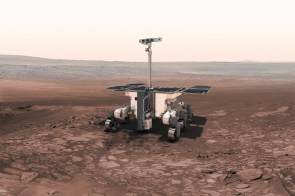Choosing the ExoMars 2020 landing site
The surface area of Mars is approximately 145 million square kilometres, almost the same area as the Earth's land masses. Imagine having to choose just one spot to land on and call home. Selecting the right place could mean the difference between achieving your scientific goals and failure. That's one of the tasks facing ESA and Roscosmos with their 2020 ExoMars mission.
Fortunately, planetary scientists have now spent decades studying Mars. They have used an array of increasingly sophisticated orbiters and rovers, and accumulated a vast library of images and information. Sifting through these data will help them guide the mission to a scientifically interesting place on the planet.
 |
| The ExoMars rover. Credit: ESA |
ExoMars 2020 has two science elements. A rover will investigate the local geology and search for signs of past and present life while a surface platform will study the martian environment. The landing site must be a geologically diverse site that is ancient, and shows the strong potential for once having been habitable. For ancient, read older than 3.6 billion years. Potentially habitable in this context means that there must be abundant evidence that water was once present for extended periods or was frequently recurring at the site.
It must also be safe for landing. No safe landing, no science.
Uncertainties about the state of the martian atmosphere mean that a landing site cannot be pinpointed with absolute precision. The ExoMars descent module will enter the martian atmosphere travelling at approximately
A radar will measure the distance to the ground and the module's speed over the terrain. The computer will receive this information and combine it with its knowledge of the descent module's attitude to decide how and when to start the controlled landing phase, which uses rocket engines. Legs will be used for the final touchdown.
With these uncertainties in mind, the best that can be done is to make a probabilistic prediction for the likely landing location. This analysis results in a possible area having the shape of an ellipse. For ExoMars, the landing ellipse is 104km by 19km.
The mission needs enough atmosphere to effectively slow down its descent, hence the landing site must be in a low-lying area of the planet. It must not contain features that could endanger the landing, such as many craters, steep slopes, and large rocks.
Checking that all these requirements are satisfied is a tough job that will take years to complete.
The first step in the process of determination was to put together a group of top scientists who understand the martian terrain. A call for applications was published on 1 November 2013. Following this, ESA put together the ExoMars Landing Site Selection Working Group (LSSWG), a team capable of dealing with the science and engineering constraints that need to be verified before a landing site can be "certified" for the mission.
The next step was to ask the wider community of planetary scientists for their suggestions for the landing site. This was initiated in December 2013 and by 28 February, eight proposals responding to the requirements were received.
The next job was to sift through the suggestions and begin the process of drawing up a shortlist. The first discussion meeting of the LSSWG took place in Madrid, 26-28 March 2014. Here the teams that had proposed landing sites came and presented their selections. On the final day, a discussion took place about the various sites.
Factors such as a proposed site's applicability to the mission's objectives, and its compliance with the technical requirements were talked about.
The LSSWG took all of the inputs from the workshop and began their deliberations. By October, a short list of four possible landing sites was drawn up. A second Landing Site Selection Workshop was held in December 2014; all four candidates were retained for further study.
In October 2015, the third Landing Site Selection Workshop was held to discuss progress. At this meeting, the Landing Site Selection Working Group recommended that Oxia Planum be considered as one of the two candidate landing sites for the launch opportunity in 2020, with a second to be selected from Aram Dorsum and Mawrth Vallis. The fourth Landing Site Selection Workshop was held in March 2017 - at this meeting the three candidates should be narrowed to two. These will be investigated in detail for science characterisation and to ensure that they meet engineering constraints.
Finally, about a year before the launch, ESA and Roscosmos will make the final decision of where to send the mission.



